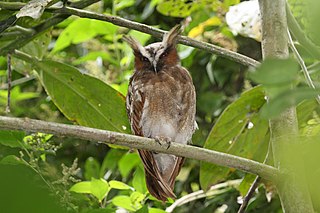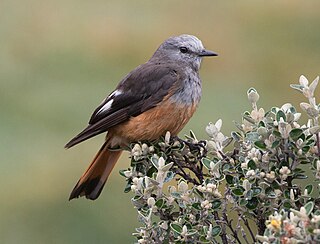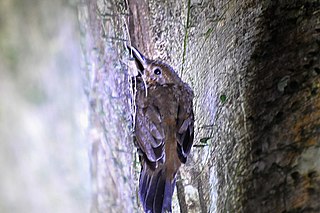Neacomys spinosus, also known as the common neacomys, common bristly mouse, or bristly mouse, is a nocturnal rodent species from South America in the genus Neacomys. It is found in Bolivia, Brazil, Colombia, Ecuador and Peru, where it often lives in transition areas between lowland forest and open regions. Its diet consists of insects, seeds and fruit.

The stripe-faced wood quail is a species of New World quail. It is found in Bolivia and Peru.

The spot-winged wood quail is a species of bird in the family Odontophoridae. It is found in Brazil, Argentina and Paraguay, and formerly in Uruguay. In Portuguese and Spanish the bird is called uru.

The marbled wood quail, also known as the Amazonian wood quail, is a species of bird in the New World quail family. It has an extensive distribution in Central America and the northern part of South America. Its natural habitat is subtropical or tropical moist lowland forests.

The rufous-breasted wood quail is a species of bird in the family Odontophoridae. It is found in Bolivia, Ecuador, and Peru primarily on the east side of the Andes between 800 and 2000m in elevation.

The speckled chachalaca is a species of bird in the family Cracidae, the chachalacas, guans, and curassows. It is found in Bolivia, Brazil, Colombia, Ecuador, and Peru.

The crested owl is a species of owl in the family Strigidae. It is the only species (monotypic) in the genus Lophostrix. It is a resident bird and occurs in Central America and northern South America. It is a medium-sized owl, easily recognizable with its very long whitish ear tufts and otherwise darker appearance. It inhabits lowland rainforests and prefers old growth in proximity with water. The crested owl is a strictly nocturnal species, but very little is known about its behaviour.

The grey-and-gold warbler is a species of bird in the family Parulidae. It is found in Ecuador and Peru. Its natural habitats are subtropical or tropical dry forests and subtropical or tropical moist lowland forests. Aspects of the grey-and-gold warbler's breeding biology were recently described by Miller et al. (2007), based on a sample of two nests. It was named after British zoologist and collector Louis Fraser.

The grey antbird is a species of bird in the antbird family Thamnophilidae. It is found in Bolivia, Brazil, Colombia, Ecuador, French Guiana, Guyana, Peru, Suriname, and Venezuela. Its natural habitat is subtropical or tropical moist lowland forests.

The red-rumped bush tyrant is a species of bird in the family Tyrannidae. It is found in Bolivia, Colombia, Ecuador, and Peru. Its natural habitats are subtropical or tropical moist montane forests and subtropical or tropical high-altitude grassland.

The red pileated finch, also known as the red-crested finch, is a species of bird in the family Thraupidae. It is found in Argentina, Bolivia, Brazil, Ecuador, French Guiana, Guyana, Paraguay, Peru, on the eastern side of the Andes. Its natural habitats are subtropical or tropical dry forests, subtropical or tropical moist lowland forests, subtropical or tropical dry shrubland, and heavily degraded former forest. This is a common species, and the International Union for Conservation of Nature has rated its conservation status as "least concern".

The speckled spinetail is a species of bird in the Furnariinae subfamily of the ovenbird family Furnariidae. It is found in Bolivia, Brazil, Colombia, Ecuador, French Guiana, Peru, Suriname, and Venezuela.

The masked flowerpiercer is a species of bird in the tanager family, Thraupidae. It is found in humid montane forest and scrub in Venezuela, Colombia, Ecuador, Peru and Bolivia. Flowerpiercers got their name from the fact that they have a sharp hook on the tip of their upper mandible which they use to slice open the base of flowers to get at the nectar.

The star-chested treerunner or fulvous-dotted treerunner is a Near Threatened species of bird in the family Furnariidae. It is found in Colombia and Ecuador.

The tawny-breasted myiobius or tawny-breasted flycatcher is a species of passerine bird in the family Tityridae. It is found in Bolivia, Colombia, Ecuador, Panama, Peru, and Venezuela. Its natural habitat is subtropical or tropical moist montane forests.

The grey-throated leaftosser is a Near Threatened species of bird in the subfamily Sclerurinae, the leaftossers and miners, of the ovenbird family Furnariidae. It is found in Bolivia, Brazil, Colombia, Costa Rica, Ecuador, Panama, Peru, Trinidad and Tobago, and Venezuela.

The black-tailed leaftosser is a species of bird in the subfamily Sclerurinae, the leaftossers and miners, of the ovenbird family Furnariidae. It is found in Bolivia, Brazil, Colombia, Ecuador, French Guiana, Guyana, Peru, Suriname, and Venezuela.

The short-billed leaftosser is a species of bird in the subfamily Sclerurinae, the leaftossers and miners, of the ovenbird family Furnariidae. It is found in Bolivia, Brazil, Colombia, Ecuador, French Guiana, Guyana, Peru, Suriname, and Venezuela.

The orange-headed tanager is a species of bird in the family Thraupidae. Native to South America, it is found in Argentina, Bolivia, Brazil, Colombia, Ecuador, Paraguay, Peru, and Venezuela, where it inhabits successional vegetation, cerrado, riparian forest, shrub, brush, and open woodland. Males of the species have sandy-gray upperparts, cinnamon to buff underparts, white on the center of the lower breast, belly, and tail, and rufous-orange and yellow heads. Females are similar but duller.

The gilded barbet is a species of bird in the family Capitonidae, the New World barbets, and are close relatives of the toucans.





















